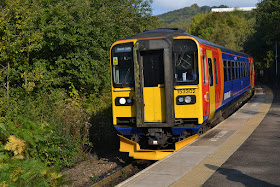 |
| EMT 153 302 at Ambergate |
Thirty-five of the Class 155s were hence converted to 70 single car DMUs by being split up and by adding a second cab to each car. Adding the extra cab was not a simple process due to the lack of available space as the existing door pocket could not be moved and the extra cab is rather compact [2].
| Information | |
|---|---|
| Number built: | 70 |
| Built: | 1987-88 (as Class 155) Converted to single cars 1991-92 |
| Builder: | British Leyland Conversions by Hunslet-Barclay |
| Engine: | Cummins NT855R5 diesel |
| Power: | 285 hp (213 kW) |
| Formation: | Driving Motor Standard Lavatory (DMSL) |
The Class 153s (as they became) quickly proved themselves to be very flexible and versatile units able to run on lightly-loaded branch lines such as the Stourbridge Town branch and the line to Cardiff Bay. They also provide a capacity boost to other routes where needed as they are able to work in multiple with other members of the "Sprinter" DMU family.
They are in service with a number of Train Operating Companies including Transport for Wales, Scotrail, Northern, East Midlands Railway and West Midland Railway.
 |
| WMR 153 354 at Ridgmont |
 |
| EMT 153 310 and friend at Attenborough |
 |
| EMT 153 382 at Duffield |
 |
| TfW 153 303 at Cardiff Bay |
 |
| EMT 153 326 at Belper |
[1] Colin J. Marsden, DMU and EMU Recognition Guide (Ian Allan, 2013) p. 134
[2] Colin J. Marsden (ed.), Modern Locomotives Illustrated No. 211 February-March 2015 (Classes 150-156 Second Generation DMUs) p. 52
